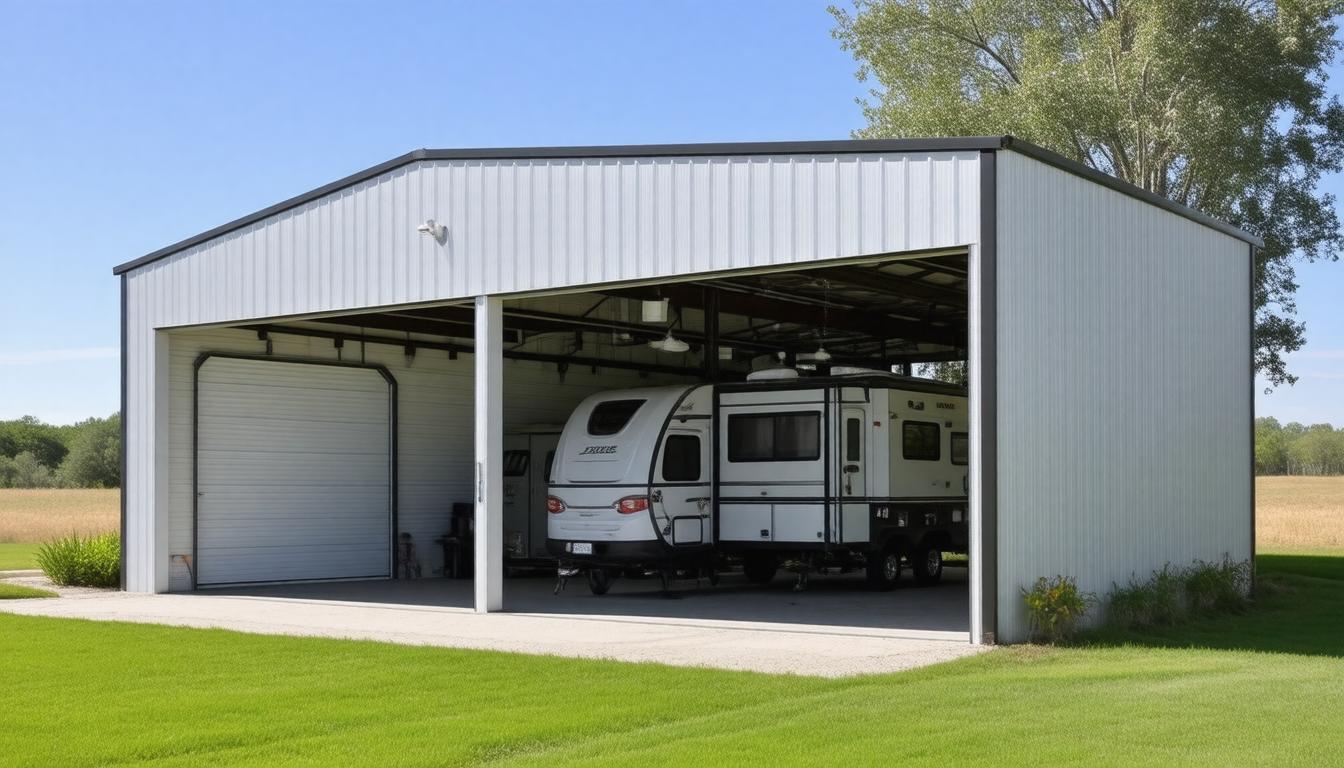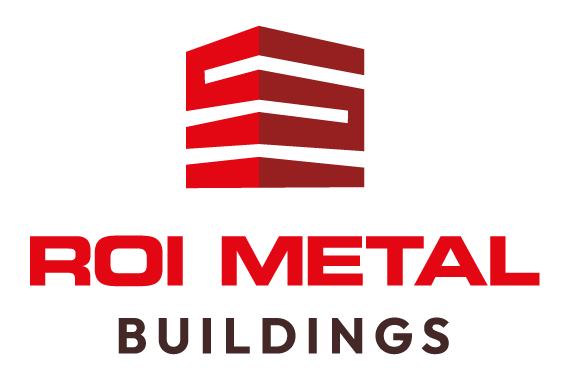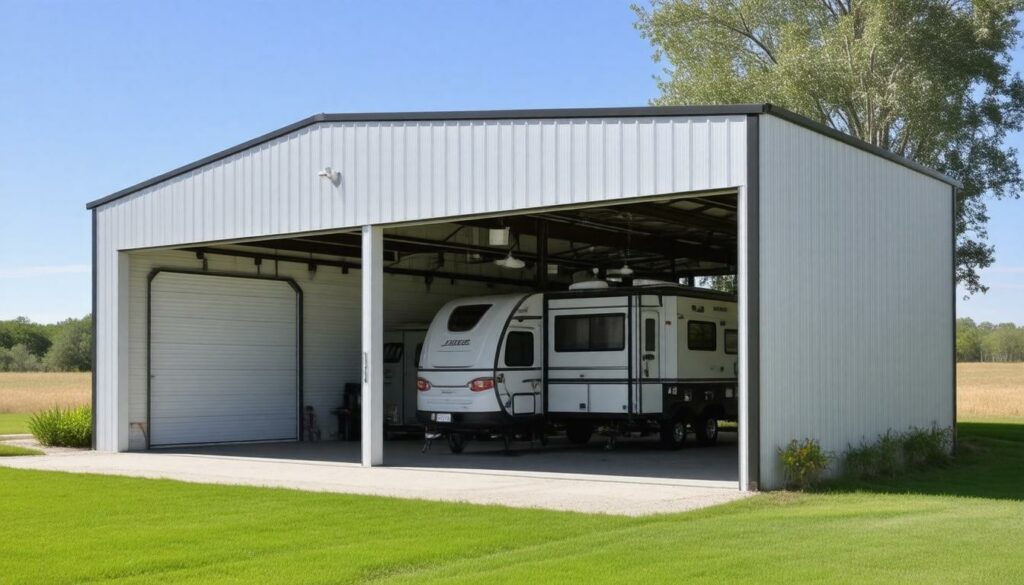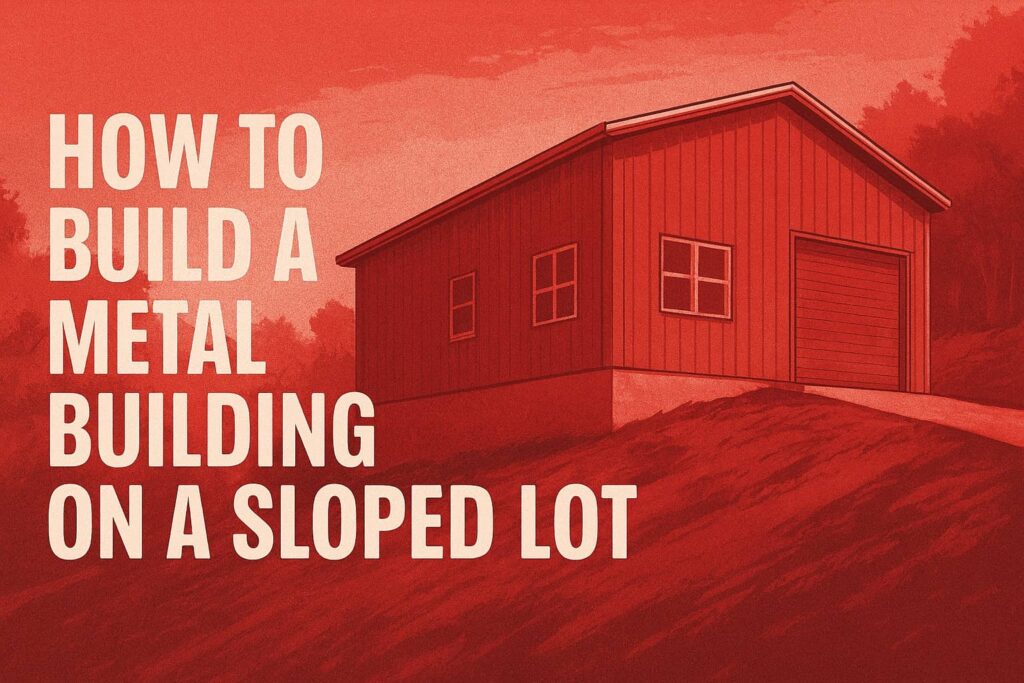When it comes to storing your RV, figuring out the right size can feel like solving a puzzle. You want to protect your beloved vehicle from the elements while ensuring you have enough room for any extras like gear or tools. Metal RV storage buildings are a popular choice because they offer durability and versatility, but with so many sizes available, how do you know which one is best for you? Don’t worry; we’ve got you covered. Let’s dive into what sizes are available for metal RV Storage Buildings!
Whether you own a small camper van or a massive Class A motorhome, understanding the different dimensions and their benefits can help you make an informed decision. Let’s dive into the various sizes available and how each can meet your specific needs!
Recently, we published an article about Insulation Options For Commercial Metal Buildings and the feedback has been great! One of the great questions that we got was about Metal RV Storage buildings in particular. After the conversation, we decided to branch off our previous topic for a moment to discuss Metal RV Storage buildings in particular. This week we will start by talking about what sizes are available for Metal RV Storage Buildings. Join us in the coming few days and/or weeks while we answer your questions about commercial metal buildings. Today we are going to dive deep on insulation options for commercial metal buildings.
Metal RV storage buildings come in a variety of sizes to accommodate different needs, ranging from smaller units designed for a single RV to larger structures that can house multiple vehicles. Common standard widths include 12 feet, 18 feet, and 24 feet, while lengths can range from around 20 feet to over 60 feet, allowing you to customize the building according to your specific requirements.

Common Dimensions for RV Storage
Knowing the typical sizes for metal RV storage buildings is crucial, especially when you’re trying to determine what fits best for your recreational vehicle.
Popular widths usually include 12 feet, 18 feet, and 24 feet. These choices allow flexibility depending on the type of RV you own and whether you plan to accommodate additional items or vehicles within the same structure. Lengths can vary widely, starting from around 20 feet all the way up to 60 feet, which typically covers most standard RVs on the market.
Let’s examine some specific dimensions that customers commonly choose. A size of 12×20 feet is ideal for smaller travel trailers or Class B motorhomes; it provides just enough room for snug, safe storage without unnecessary excess. On the other hand, sizing up to 18×30 feet offers extra space needed for a mid-sized RV or fifth wheel, ensuring comfortable storage and access. For larger Class A motorhomes or multiple RVs, a dimension of 24×40 feet allows ample maneuverability while providing secure protection from the elements.
Customization is key because each RV brings its unique size and shape to consider.
Beyond basic RV storage, many owners are transitioning their metal buildings into multifunctional spaces. As demand rises for features beyond mere parking—like workshops or added living quarters—having dimensions that can flexibly cater to these needs is essential. Various configurations also include height options ranging from 10 to 16 feet, enabling homeowners to store taller vehicles or install shelves and additional equipment above.
These varying sizes not only accommodate different types of RVs but also provide flexibility in how you use your space:
- Standard single RV storage: *12’ x 30’ (width x length)*—great for a solo vehicle.
- Standard double RV storage: *12’ x 40’ (width x length)*—capable of handling two smaller units together.
- Large RV storage: *14’ x 50’ (width x length)*—perfectly balances roominess with utility.
- Extra-large RV storage: *14’ x 60’ (width x length)*—best suited for large setups or multiple vehicles side by side.
With various options available based on these common dimensions, envisioning the right fit becomes easier. This leads us toward exploring how customizations can further enhance your space according to your individual requirements.
Custom Widths and Lengths
When it comes to customizing the dimensions of your metal RV storage building, there’s a remarkable flexibility that allows you to tailor the structure to perfectly suit your needs. This is particularly beneficial if you have specialized requirements or an irregular lot shape that doesn’t conform to standard dimensions. By working with a broker like ROI Metal Buildings, you can configure widths starting from a compact 10 feet and extend all the way up to 60 feet or more. Even the lengths are equally varied, offering options from 20 feet right up to over 100 feet.
Such customization ensures that regardless of whether you own a single small RV or multiple oversized vehicles needing ample space, you can create a dedicated structure that fits seamlessly within your available property.
One of the standout features about these made-to-order structures is their adaptability for various uses beyond mere vehicle storage. Many customers have transformed their RV storage spaces into multipurpose areas—think workshops or even comfortable living quarters when traveling. Depending on your situation, a wider building might allow for added amenities such as workbenches or storage shelves without cramping your style.
Let’s take a closer look at how various sizes cater to different types of RVs. Structures with widths ranging from 10 to 15 feet and lengths extending from 20 to 30 feet typically serve well for compact single RVs. Meanwhile, larger configurations with widths between 16 to 25 feet and lengths from 30 to 50 feet accommodate medium to large RVs comfortably. If you’re managing multiple vehicles or oversized models, opting for widths spanning 26 to 60 feet and lengths from 50 feet onward can provide room not just for parking but also for additional gear.
| Width (ft) | Length (ft) | Typical Use |
|---|---|---|
| 10-15 | 20-30 | Single compact RV |
| 16-25 | 30-50 | Medium to large RVs |
| 26-60 | 50-100+ | Multiple or oversized RVs |
The ability to create versatile and spacious options empowers you to optimize your property while meeting your current and future needs seamlessly. With this understanding, let’s explore how larger designs specifically cater to the demands of bigger vehicles.
Large Storage Spaces for Oversized RVs
When it comes to oversized RVs, having spacious storage is not just a luxury—it’s a necessity. Large structures typically range from 30×40 feet to even 50×100 feet, designed specifically to provide ample room for maneuvering and protecting these sizeable investments. For instance, a 40×80 feet building can easily house your Class A RV while providing extra space for accessories, maintenance equipment, or even supplies for your next adventure on the road.
One of the key benefits of large RV storage spaces is their versatility. Not only do they provide shelter from harsh weather like rain and snow, but they also offer enough room for owners to perform maintenance tasks right inside the structure. Imagine being able to walk around your RV without worrying about bumping into walls or other vehicles—this freedom can make all the difference when preparing for long trips or completing repairs.
Moreover, many of these buildings come equipped with features like roll-up doors, often measuring 12 to 14 feet wide, that facilitate easy entry and exit. This means no awkward maneuvers or tedious backing out; you can simply roll right in and park with ease.
Customers who choose larger dimensions quickly realize they’re investing in protection that goes beyond what standard carports offer. Larger metal storage options often include ventilation systems to prevent moisture buildup that can lead to mold and rust over time. In states with extreme temperatures, this added feature becomes particularly valuable.
John from Texas shared his experience: “I own a 45-foot Class A RV, and the 50×100 feet building from ROI Metal Buildings has been a perfect fit. I have room not just for my RV but also my tools and equipment, which makes everything so much easier.”
As you assess your storage needs for recreational vehicles, exploring different sizes can provide practical solutions tailored to your specific requirements—especially if you’re considering smaller vehicles as well.
Compact Buildings for Small Vehicles
Compact RV storage solutions are particularly useful for owners of smaller vehicles, such as Class B camper vans or travel trailers. These structures offer functionality without the bulk typically associated with larger models. Dimensions like 12×20 feet or 15×25 feet are common; they fit snugly in tighter spaces while providing substantial protection against various weather conditions.
Opting for compact RV storage isn’t merely about fitting within property size restrictions. It’s an investment that promotes cost-effectiveness while maximizing land use efficiency. Given rising prices, specially designed compact solutions help alleviate financial strains without sacrificing quality. Moreover, they often require less time to set up than larger counterparts, allowing you to enjoy your new space sooner.
It’s crucial to consider not just the length and width but also the height and clearance needs of these buildings. Typical height options range from 10 to 14 feet, ensuring almost any small RV has sufficient vertical room for parking without risking damage to the roof. Proper height is essential, especially during peak growth seasons when overhanging branches could pose a significant threat.
Speaking of customization, many compact metal buildings allow for personalized features that further enhance usability.
Customization Options
When it comes to compact RV storage buildings, customization is key to meeting individual needs. Features like roll-up doors facilitate seamless entry and exit, while ventilation systems maintain air quality inside the building. Additionally, insulation options may be prudent depending on climate considerations—especially if you plan to use the structure throughout the year or combine it with living quarters.
Having the ability to customize not only prioritizes convenience but can also enhance the longevity of your investment by ensuring optimal conditions inside.
Choosing compact buildings also offers ease of accessibility. The reduced footprint means navigating around these structures is generally hassle-free, making them ideal even in constrained residential settings where maneuverability can be a challenge. As an extra layer of security, some facilities offer features like padlocks or electronic access control systems—protecting your capital investment.
Understanding these elements can effectively inform your choices as you explore further details regarding structural considerations such as height and clearance requirements.
Height and Clearance Factors
When it comes to RV storage, considering height and clearance isn’t just a matter of convenience; it can significantly impact your overall experience. Most recreational vehicles, especially larger models like Class A motorhomes, typically require a minimum clearance of about 12 to 14 feet for safe entry and exit. This requirement ensures that you won’t scrape the roof on the entrance or face unexpected challenges with other accessories like rooftop air conditioning units.
However, if you’re thinking long-term or expect future upgrades to your RV, it’s wise to aim for heights around 16 feet or more. Choosing a taller structure accommodates current requirements while providing enough room for those future installations. Imagine driving home with your new rooftop cargo carrier only to realize it won’t fit inside your building. This foresight will prevent you from encountering such frustrating scenarios.
Companies like ROI Metal Buildings recognize this importance by offering customizable height options that range from 12 feet to over 20 feet. This flexibility means that no matter how large or high your RV is, there’s likely a building designed specifically for your needs. Customization doesn’t stop at height; you can even tailor features to suit your lifestyle and vehicle specifications.
Consider this: as more Americans embrace the RV lifestyle—with nearly 9 million recreational vehicles now on the roads—the demand for appropriately sized storage solutions continues to grow exponentially.
While selecting an appropriate height may seem straightforward, it’s critical to establish what will best serve your various needs, which helps avoid costly mistakes down the line. As we look further into this topic, it’s essential to explore innovative approaches that enhance storage efficiency and adaptability for the future.
Modular and Expandable Options
Modular and expandable RV storage buildings offer an exciting blend of functionality and flexibility tailored to suit evolving requirements. At their core, modular buildings are constructed from individual prefabricated sections, simplifying both the initial construction and potential future expansions.
Imagine starting with a compact 20×40-foot unit that perfectly fits your current needs; however, as your collection grows or if you decide to integrate other uses—like a workshop—you can seamlessly expand it to a spacious 40×40 feet without major renovations. This adaptability is incredibly valuable in an ever-changing world.
The beauty of this system lies in its simplicity; choosing a modular design means investing in a storage solution that can grow alongside your lifestyle. Say you’re planning on upgrading your recreational vehicle or adding more toys to your collection – simply purchase another module or two! This approach saves you from considering costly new builds down the line while maintaining a cohesive design aesthetic since each addition will match the original structure.
By choosing modular designs, homeowners can enjoy the convenience of future-ready structures that accommodate growth easily and affordably.
When contemplating the capabilities of these structures, one key feature emerges: their potential for customization. Aside from expanding size, many manufacturers allow for personalized touches such as roll-up doors, windows, insulation, or even electrical setups. This means each structure can be tailored to meet specific climate concerns or intended uses beyond just parking RVs. For instance, if you live in a hotter climate, adequate insulation could make the building exceptionally comfortable during summer outings.
Moreover, common sizes and expansion options include:
- Starting dimensions like 12×20, 20×30, and 30×40 feet
- Expansions available in increments of 10 feet for both width and length
- The average cost typically ranges between $20 to $40 per square foot depending on customization choices
Transitioning from traditional structures to modular designs reflects a modern philosophy that values efficiency while addressing practical needs. Manufacturers often provide pre-engineered kits which reduce construction time significantly—by approximately 30-50%. If you’re thinking about constructing one of these buildings, you’ll appreciate how easy it is to assemble them on-site.
Whether you seek simple storage solutions or envision multipurpose spaces within your metal structure, considering modular options ensures that your investment remains relevant through changing circumstances. Each design choice plays a crucial role in maximizing space efficiently.
Selecting the Right Size for Your Needs
Choosing the correct dimensions for your RV storage solution involves a blend of practical considerations and future planning, reflecting both your current needs and aspirations. Begin by conducting a thorough assessment of your RV inventory. Not only should you consider the vehicles currently occupying your driveway or storage lot, but it also pays to think ahead about potential upgrades or additions.
For instance, if you’ve been eyeing a larger model or plan to expand your family of recreational vehicles, invest in a larger or modular facility that can grow with you.
Having an accurate understanding of your vehicle’s dimensions is equally essential.
Step I – Assess Your Current and Future RV Inventory
Don’t just count your current RVs; take note of their lengths as well! It’s easy to assume a 20-foot trailer will fit in a 12-foot wide space, but many people forget that they need more than just length. The importance of planning for future vehicle purchases cannot be overstated. This foresight can save you time and money down the road, as inadequate space can lead to costly second moves or ultimately damage to your property if too many vehicles are stacked together.
Next, height is often overshadowed but is just as vital for accommodating various vehicle designs.
Step II – Measure Heights Including Attachments
When measuring whether your RV will fit comfortably within its new home, don’t omit attachments like antennas, air conditioners, or satellite dishes. These often add significant height to an otherwise standard vehicle profile. Ideally, measure from the ground up to the tallest point of your RV and then add a comfortable buffer to ensure plenty of clearance when moving in and out. A good rule of thumb is to allow at least 12 inches above the highest point to prevent any accidental roof scrapes during entry or exit.
After assessing physical sizes, it’s time to think about other gear that often comes along on your adventures.
Step III – Consider Additional Storage Needs
While an RV serves its primary function for travel and exploration, it’s wise to remember all the additional equipment that accompanies these outings. Think about camping gear, bicycles, tools, or even spare parts—all need their own designated spot. Planning space for these items while determining building dimensions can help streamline your campsite setup and keep everything organized within reach. Opting for extra square footage now could mean less clutter later on when you’re ready to launch into another adventure.
Lastly, harnessing expertise can offer insightful guidance tailored toward your unique situation.
Step IV – Consult Experts
Don’t hesitate to seek out professionals who specialize in metal building design; they can provide invaluable advice tailored specifically to your needs. At ROI Metal Buildings, experts understand the nuances of selecting an appropriate size based not only on typical dimensions but also assessing local regulations or code requirements relevant to your area. Their expertise helps simplify complexities involved in sizing decisions by providing comprehensive insights and custom designs without charging fees for quotes.
Can I get a custom-sized metal RV storage building tailored to my specific needs?
Yes, you can get a custom-sized metal RV storage building tailored to your specific needs. Many manufacturers offer customizable options that allow you to choose dimensions, materials, and features according to your requirements. This flexibility ensures that you can accommodate various RV sizes and additional storage needs, enhancing the functionality of the building. In fact, around 70% of buyers opt for custom designs to maximize space efficiency and suit their individual preferences.
What is the average cost difference between standard and custom-sized metal RV storage buildings?
The average cost difference between standard and custom-sized metal RV storage buildings typically ranges from $2,000 to $5,000, depending on the specific dimensions and design features. Standard sizes, which are readily available and produced in bulk, tend to be more economical due to lower manufacturing costs. In contrast, custom sizes require tailored production processes and additional materials, leading to increased expenses. Statistics show that approximately 30% of buyers opt for custom designs, citing factors like unique vehicle dimensions or specific site requirements as their primary reasons for customization.
Are there standard dimensions for RVs that can help determine the appropriate building size?
Yes, there are standard dimensions for RVs that can help determine the appropriate building size. Typically, Class A RVs range from 26 to 45 feet in length, while Class B and C RVs vary between 20 to 33 feet. When selecting a metal storage building, it’s advisable to add at least an additional 2-3 feet in width and height to accommodate maneuverability and any additional storage needs such as outdoor gear. This ensures that the building not only fits the RV comfortably but also provides space for easy access and maintenance.
How do local zoning regulations affect the size options for metal RV storage buildings?
Local zoning regulations play a crucial role in determining the size options for metal RV storage buildings, as they often dictate setbacks, height restrictions, and overall footprint limits based on land use categories. For instance, residential zones may impose stricter limitations compared to commercial or agricultural zones, often capping building sizes to maintain neighborhood aesthetics and ensure safety. According to the American Planning Association, about 30% of municipalities have specific rules regarding accessory structures, which frequently include RV storage. As such, prospective builders must thoroughly check their local zoning codes before planning to avoid costly adjustments or permits.
What factors should I consider when choosing the size of a metal RV storage building?
When choosing the size of a metal RV storage building, consider the dimensions of your RV, including height, width, and length, as well as any additional space needed for accessories or maintenance access. It’s essential to allow for at least an extra 1-2 feet of clearance on all sides to ensure easy maneuverability. According to industry standards, a typical RV can range from 22 to 45 feet long; thus, opting for a building that accommodates larger models—usually around 14-16 feet in height and corresponding width—ensures proper fitment and future flexibility for potential upgrades or additional vehicles.
Summary: What Sizes Are Available For Metal RV Storage Buildings?
With the right information and expert guidance from ROI Metal Buildings, you can ensure that you select the perfect size for your metal RV storage building, allowing both practicality and peace of mind for all your adventures ahead.
Taking the time now to thoughtfully assess your options will pay off in convenience and organization down the line. If you need help with RV Metal Storage buildings, please reach out by calling us at (865) 316-9009 or fill out our contact form today! Also, if you like our content and want to stay up to date, follow us on Facebook at https://www.facebook.com/roimetalbuildings!




